The Everest trek involves a tremendous amount of up-and-down walking. All the rivers in this part of Nepal flow south form Himalayan glaciers, but the trek route proceeds east. Therefore the trail must climb to the ridge that separates two rivers, descended to the river itself, and ascend the next ridge. Even though the trek begins at an elevation of 1,860 m, on the sixth day it crosses the DudhKosi at only 1,500 m – after considerable uphill climbing, it will come to almost 5,360 m of elevation to Everest Base Camp.
The Nepal Himalayas are best seen on this trek as one traces the main route through the Khumbu region
from the Sherpa town of Namche Bazaar. The trekkers get a close view of the world’s greater mountains
such as Mt. Everest (8,848 m) and others mountains like Lhotse, Nuptse, Thamserku, and Tawache. The
Everest Base Camp Trek takes one to the foothills of the mightiest of the mountains in the world. En
route, traverse through rhododendron and pine forests, rivers, Sherpa villages and Buddhist
Monasteries from temperate to snow line regions.
FEATURES
| Mountains: | The Khumbu Himalaya Range: Everest, Lhotse, Thamserku, Ama Dablam,Nuptse, Tawatse, Kantega, Pumo Ri, etc. |
|---|---|
| Rivers: | BhoteKosi, Lobuche Khola and Dudh Kosi. |
| Best Season: | December 8-22,2021 |
| Ethnic Tribes: | Mostly Sherpas and Tibetans in Namche Bazaar, Thyangboche, Pheriche, Lobuche, Lukla with monasteries, chortens and Mani stones. |
| Forests: | Rhododendron and Pine. |
| Landscapes: | Varying from temperate valleys to snow clad mountains. |
| Grade: | 4 |
| Flights: | Both ways from Kathmandu to Lukla & back |
| Warning: | Altitude Sickness. |
| Accommodation: | Hotel in Kathmandu and Teahouse lodges on the trek |
Cost:
- Rs. 73,750/- (For Indians)
- USD 1,120/- (For Foreigners)
- The cost is per person based on a minimum group size of 4 pax
- 5% GST to be added
Extras:
| Airfare (Kathmandu / Lukla / Kathmandu) | Indian PP Holders | Foreign PP Holders |
|---|---|---|
| Airfare (Kathmandu / Lukla / Kathmandu) | INR 18,750.00 Net per pax.* | US$ 360.00 Net per pax |
*Subject to change
Cost Includes:
- Group arrival and departure tranfers
- Sightseeing tour in a private tourist vehicle accompanied by English-speaking guide
- 3 nights stay at hotel in Kathmandu on twin-sharing basis including American breakfast and all taxes
- Teahouse trek as per itinerary including all meals, accommodation at lodges and Teahouses, and the service of English-speaking trek leader and a team of experienced Sherpa assistant/s and a reliable porters
- Sightseeing tours as per itinerary including applicable monumental entry fees
- Sagarmatha National Park fees
Cost Exclude:
- International airfares and airport departure taxes
- Individual International airport arrival and departure tranfers.
- Nepal entry visa (US$ 25 per person)
- Airfare for sector Kathmandu / Lukla / Kathmandu (Quoted Seperately)
- Items of a personal nature such as; laundry, bar bills, alcoholic beverages (except on welcome dinner), extra mileage, optional tours such as mountain flights, telephone calls, internet services, personal gratuities as tips to guides, bell-hops or hotel porters, drivers, etc.
- Comprehensive Travel Insurance or “Umbrella Insurance” to cover – Illness, hospitalization, travel medicines, loss of valuables, thefts, change of itinerary, flight and tour cancellations due to unavoidable circumstances and most of all Emergency Helicopter Charter for evacuation purpose.
- Lunch and dinners in Kathmandu
- Any items that are not mentioned in above the costs include section
WHAT YOU CAN EXPECT FROM THIS ADVENTURE TRIP
DAY TO DAY ITINERARY
Day 1: ARRIVE IN KATHMANDU
Day 2: DAY 02: FLY TO LUKLA (2,880 m/9,448 ft) & START TREK TO PHAKDING (2,652 m / 8,700 ft;3 hrs.)
The trek starts by following the trail leading to the northwest direction through the narrow street, which immediately descends from the end of the village on a trail through the open hillside. The trail is well defined and there are many shops and lodges catering to trekkers. Today’s trek is an easy one and ultimately descends to the river at Phakding.Dinner and overnight at teahouse lodge.
Day 3: PHAKDING TO NAMCHE BAZAAR (3,447m / 11,300 ft – 5-6 hrs)
up a very steep trail to Namche Bazaar. Near half waypoint, we enjoy our first views of Mt. Everest (8,848 m/29,028 ft), Nuptse (7,879 m/25,849 ft) and Lhotse (8,383 m/27,503 ft) – the big three. The climb is for nearly 3 hours as one gains altitude, making breathing difficult due to the rarified air. Arrive at a gate with a sign saying, “Welcome to Namche Bazaar” but it is very misleading as it takes another 20 minutes to arrive at the main town.
This prosperous town is the largest in Khumbu. Mt. Thamserku (6,648 m/21,811 ft) and Kwangde Ri (6,624 m/21,732 ft/18,723 ft) loom along the east and west of the village. The sacred mountain Khumbila (5,707 m) dominates the skyline along the west.Dinner and overnight at teahouse lodge.
Day 4: REST DAY FOR ACCLIMATIZATION IN NAMCHE.
Day 5: TREK TO DEVOUCHE VIA THYANGBOCHE MONASTERY (3,800 m / 12,464 ft; 7 hrs)
The afternoon is spent climbing slowly a steep trail to the Thyangboche Monastery. Thyangboche lies at the base of Kangtega with superb views of Ama Dablam, and the Everest poking its southwest face over the huge ridgeline linking Nuptse and Lhotse. The Thyangboche Monastery is one of the most important monasteries of the Khumbu Region and the late afternoon can be spent visiting this ancient monastery. It is the traditional place where all Everest expeditions receive their blessings as they walk in towards the base camp. After visiting Thyangboche Monastery a short, steep and muddy descent to Devouche through a forest of birches, conifers and rhododendrons.Dinner and overnight at teahouse.
Day 6: TREK TO PHERICHE (4,220 m / 13,840 ft; 5 hrs)
Pangbouche. For the next half an hour the path is on level ground with few gentle climbs. We have to go uphill for about 45 minutes to reach our lunch point. After lunch at Somare the trails goes up to the left, through the front yards of a few herders’ huts, over a stone wall and climbs a small ridge before descending to Khumbu Khola, crossing it on a wooden bridge. From the bridge it is 10-minute-walk, usually in the wind to Pheriche which is a windier place and is colder than most places in Khumbu.Dinner and overnight at teahouse.
Day 7: REST DAY FOR ACCLIMATIZATION
to have a rest day to acclimatize at this altitude before starting an ascent. The trekkers’ aid post operates at Pheriche, supported by the Himalayan Rescue Association and Tokyo Medical College. A western physician is usually in attendance during the trekking season. This establishment, and the doctors who operates it, specialize in the study and treatment of altitude sickness and strive to educate trekkers in the dangers of too fast an ascent to high altitudes.Dinner and overnight at teahouse.
Day 8: PHERICHE TO LOBUCHE (4,931 m / 16,173 ft – 5 hrs)
After Thukla, there is a very steep ascent for about one hour to the ridge where there is a Sherpa memorial in remembrance to those brave mountaineers who died during expeditions. Travel along the jumbled moraines and scattered rocks passing by the memorials of Rob Hall and
Yasuko Namba and others who perished during the Mt. Everest disaster of 1996. The memorial chortens dots the skyline facing the mountains and overlooking the valley below. Further on the trail leads to the moraine of the Khumbu Glacier with views of Pumori or Widow’s Peak in the foreground. The stark and the rugged beauty create almost a moonscape. The teahouse at Lobuche is reached for lunch, after another hour of steady trekking through the moraine and is situated in a windswept valley with the views of the Tawatse (6,501 m/21,328 ft) and Nuptse (7,855 m/25,849 ft).Dinner and overnight at teahouse.
Day 9: LOBUCHE TO GORAKSHEP (5,160m) AND CONTINUE TO EVEREST BASE CAMP (5,364 m / 17,593 ft. - 7 hrs)
Climb slowly to a ridge and then continue on a trail of rocks caused by rockslides. On a clear day Mt. Everest can be seen looming behind Nuptse. Arrive at the ridge above Gorakshep and then descend to Gorakshep, a settlement with few teahouses to stay overnight. This was the base camp for the 1952 Swiss Everest expedition. In 1953 A.D. the British Everest expedition called this ‘lake camp’. Gorakshep or ‘graveyard of the crows’ has a small lake that is usually frozen and several monuments to climbers who have died during various Everest expeditions. The carved stone in memory of Jake Britenbach, US expedition and the monument of Indian Ambassador H. Dayal, who died during a visit to the Everest Base Camp after the 1965 A.D, Indian expedition, are northeast of the lake.
After lunch early lunch at Gorakshep start hike to Everest Base Camp, while fascinating, is not spectacular as the ascent of Kala Pattar because there is no view of Everest itself from the base camp. Mt. Lhotse and Mt. Nuptse, which loom over the Base Camp, shades the view of Everest. The trail continues on a ridge from where a small glimpse of Mt. Everest can be seen. At the end of the ridge, a scrabbling descent leads to the entry into Khumbu Glacier. The trail through the glacier is an interesting one in that one can actually feel, as if one is inside a fridge with the cold seeping from all sides. The Everest Base Camp is also the site for the base camp for Lhotse and Nuptse. It is not actually a specific site as various expeditions have elected different locations for a semi-permanent camp during their assault on the mountains. Some of the sites that expeditions have used as base camps are identifiable form debris on the glacier at 5,360 m or more.
However the highlight of the trip to this place is the sight of the Khumbu icefall and the trek along the Khumbu icefall is an interesting and an exhilarating one. Later return to Gorakshep for overnight.Dinner and overnight at teahouse.
Day 10: CLIMB KALAPATTHAR (2 hours; 5,545 m / 18,190 ft.) & BACKTRACK TO PANGBOCHE (4,220 m / 13,840 ft – 8 hrs)
return journey back to Pangboche via Periche.
Dinner and overnight at teahouse
Day 11: BACKTRACK TO NAMCHE (3,447 m / 11,300 ft; 8-9 hrs)
Continue through this village and ascend to a pass. Then we descend steeply for about 30 minutes to arrive at the spectacular little bridge over the river and leads into the fir and rhododendron forest and a lovely afternoon’s walk of another 40 minutes brings us to the meadows and the village to Devouche for lunch. After lunch there is a steep ascent for 30 minutes to reach Thyangboche. It is a classic setting with superb views backs up the valley to the Ama Dablam, and the Everest poking its southwest face over the huge ridgeline linking Nuptse and the Lhotse. At the rear is the beautiful west face of the Tamserku (6,608 m/22,335 ft) and Kang Taiga (6,685 m/21,932 ft).
From here descent to the ImjaKhola and the small village of Phunki (3,250 m/10,662 ft) with its water powered prayer wheels takes about one and half hour. The original bridge built by Sir Edmund Hillary was washed away when a flood caused by the landside from the Ama Dablam caused a flooding in this region. Cross the river over the smaller bridge and start the climb towards Sanasa and from here Namche Bazaar is about one and half hour.Dinner and overnight at teahouse.
Day 12: TREK TO LUKLA (2,880 m / 9,446 ft; 8 hrs)
In the evening Sherpa bid farewell at a party. Dinner and overnight at teahouse.
Day 13: FLY TO KATHMANDU (30 min) & TRANSFER TO HOTEL
Day 14: SIGHTSEEING IN KATHMANDU CITY
Pm: After lunch drive up to the Swayambhunath Stupa situated atop a hill from where you could get a bird’s eye view of Kathmandu Valley. The Swayambhunath Stupa is also known as the “Monkey Temple”!!Overnight at hotel in Kathmandu.
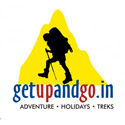
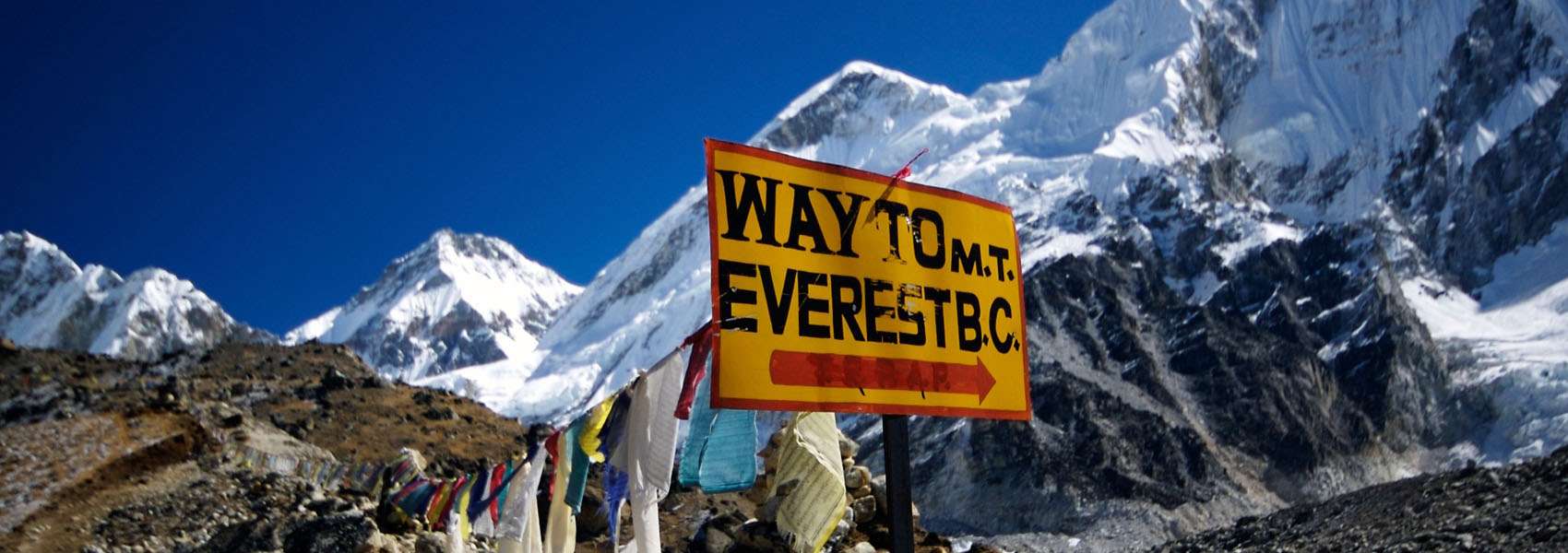
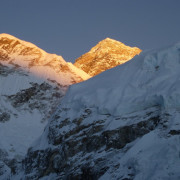
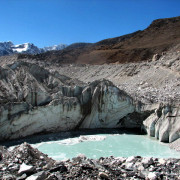
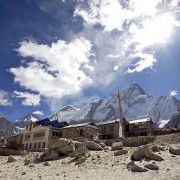
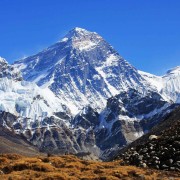
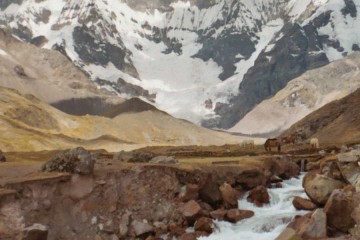

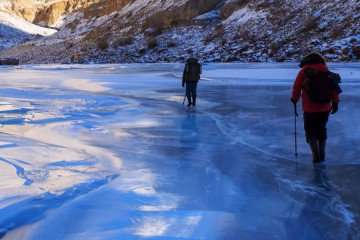

Tour Reviews
A must-do trek for all you trekking fanatics!! It was an incredible experience. Not as hard as I had imagined it would be and awesomely beautiful!! Such amazing peaks…towering above you, and the monasteries…simply serene! But… you have to be fit and prepared to attempt the Sagarmatha basecamp! The tea houses are luxurious and comfortable, the food is great and the long walks everyday, make the tea houses a welcoming sight. One of my best treks till date!!
Leave a Review